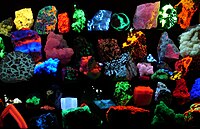
Photo from wikipedia
Carbon “quantum” dots (CDots), generally defined as small carbon nanoparticles with various surface passivation schemes, have emerged to represent a rapidly advancing and expanding research field. CDots are known for… Click to show full abstract
Carbon “quantum” dots (CDots), generally defined as small carbon nanoparticles with various surface passivation schemes, have emerged to represent a rapidly advancing and expanding research field. CDots are known for their bright and colorful fluorescence emissions, where the colorfulness is associated with the emissions being excitation wavelength dependent. In this work, CDots with 2,2′-(ethylenedioxy)bis(ethylamine) (EDA) for surface functionalization were studied systematically by using steady-state and time-resolved fluorescence methods. The observed fluorescence quantum yields are strongly excitation wavelength dependent, and the dependence apparently tracks closely the observed absorption profile of the EDA-CDots, whereas the excitation wavelength dependence of observed fluorescence lifetimes is much weaker, obviously decoupled from the quantum yields. Mechanistically, the presence of two sequential processes immediately following the photoexcitation of CDots leading to fluorescence is used to rati...
Journal Title: Journal of Physical Chemistry C
Year Published: 2017
Link to full text (if available)
Share on Social Media: Sign Up to like & get
recommendations!